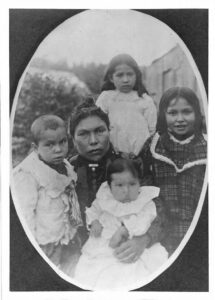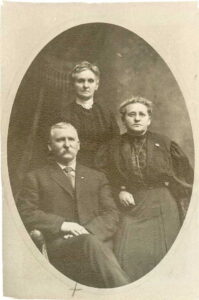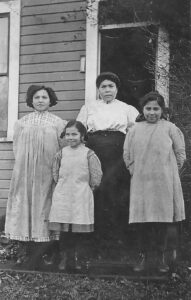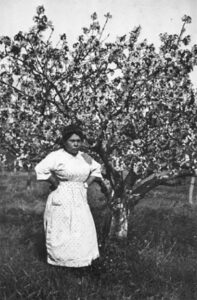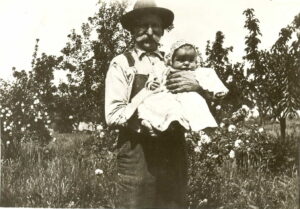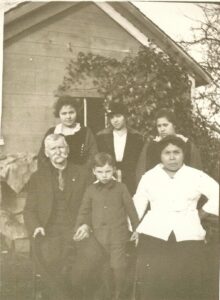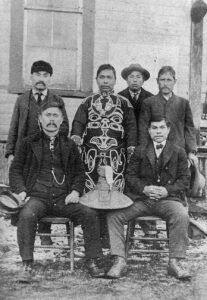 Isaac Bainter was a big, handsome, fair-skinned Pennsylvania Dutch youth accustomed to depending on himself from the time he was 14. He had been orphaned at the age of four and more or less raised by older sisters until he reached his teens. He had roamed across the country from his native Indiana and finally in his early 20s ended up in Alaska seeking his fortune during the gold rush.
Isaac Bainter was a big, handsome, fair-skinned Pennsylvania Dutch youth accustomed to depending on himself from the time he was 14. He had been orphaned at the age of four and more or less raised by older sisters until he reached his teens. He had roamed across the country from his native Indiana and finally in his early 20s ended up in Alaska seeking his fortune during the gold rush.
He found a fortune, all right, but not the kind he had expected and his manner of finding it almost cost him his life. While in Sitka he was stricken with typhoid fever, in those days considered an almost always fatal, contagious disease. Without family or close friends he was left to die, but Fate intervened in the person of a Tlingit Indian maiden who had been working as a maid at the army post social hall where Isaac Bainter, the young man from Indiana had gone occasionally.
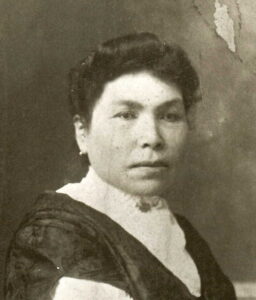 Kittie was as fearless as she was attractive. She knew what it meant to be orphaned and on her own. With compassion and skill she nursed Ike back to health and during the process they fell in love. They were married and established their home in Sitka, in the course of time becoming the parents of Lucy, Flora, Daniel and May. The rugged Alaska climate proved detrimental to Flora’s health and her doctor recommended that she be moved to a milder location.
Kittie was as fearless as she was attractive. She knew what it meant to be orphaned and on her own. With compassion and skill she nursed Ike back to health and during the process they fell in love. They were married and established their home in Sitka, in the course of time becoming the parents of Lucy, Flora, Daniel and May. The rugged Alaska climate proved detrimental to Flora’s health and her doctor recommended that she be moved to a milder location.

Ike Bainter in loganberry patch about 1932. Bean farm in background to the right; Hunziker farm to the left.
Ike Bainter and his business associate, Jim Tak, had heard that there was good work for loggers on South Whidbey so, in April, 1906, Ike, Kittie and their four children came to Everett and from there to Langley where they lived for a time at the hotel run by Roderick and Sarah McLeod. Ike was anxious to get his family permanently settled and his children in school, so after studying the area he selected 18 acres of stump land south of the new village of Langley in what is now the residential area known as Northview. He purchased the acreage and four room house from the Feltons who were related to the Hunziker family.
It was not long before the Bainter home became a sort of social center for the whole community. Kittie had a special talent for turning a house into a home, over which she presided with great humor but unquestioned authority. She was renowned for her culinary skill. It was rare indeed for the family not to have extra guests at mealtime, sometimes even for breakfast and community celebrations at their home.
Ester Anderson Moe tells of her experiences as their guest. “The Bainters were our neighbors and I used to love to go to their house. They had a phonograph with a big horn. They had a sink! And a drain lined with zinc so they didn’t have to carry out dishwater. They had an organ, too. On the wall they had a big metal frame which enclosed at least 50 photographs. They had a beautiful kerosene ceiling lamp and later carbide lamps before electricity came in.”
The Bainters were music lovers. Their phonograph was not just for show. It was the first one in the community and people came from near and far to listen to the marvelous machine which played music. During summer evenings folks would sit on stumps out in the yard and listen to the records which were often played until midnight.
The organ in the Bainter home was much more than just a show-piece. It was in steady use, as the whole family was musical. Lucy, Flora and May became famous in the community as a vocal trio and were in much demand to sing at everything from weddings and parties to funerals. Often Alma Anderson (Grist), a friend of the Bainter sisters, would play the piano or organ accompaniment. May Bainter (Frear) recalls with amusement the time when Alma owned her first auto and used to drive the girls around. Langley was still heavily forested and the roads mostly narrow, dusty, single lane curves. Whenever they came to a sharp curve (which was often) Alma would stop the car until one of the girls got out and ran ahead to make sure no other car was coming around the curve.

Not only was the Bainter home a social center but Ike Bainter was actively involved with the political and economic life of the community. He was a charter member of the Masonic lodge. Also he helped build the Methodist community church in 1909 and an uncle of the Bainters, Rev. Frank Lacy, delivered the church dedication sermon. He and his family had come from Indiana where he was a Methodist minister, to attend the Alaska Yukon-Pacific Exposition in Seattle and had continued on to Whidbey to visit their nephew and family.
Ike Bainter was actively involved with the incorporation of Langley as a town in 1913. He was a member of Langley’s first town council along with W. H. McGinnis, Angus McLeod, Ed Howard and H. J. English. Frank Furman was the mayor.
Lucy Bainter married Roy Cattron and her son, Francis Cattron, spent much of his childhood at the home of his grandparents. Flora Bainter nursed her father, Ike, through a nine year illness. Later she married Allie Vaughn and resided in Seattle. Daniel Bainter remained a bachelor but was well known around Langley.
After graduating from high school May went to work for E. E. Noble, Sr., in the Langley bank. It was there that she met Robert Frear whose parents had settled near Lone Lake in 1920. Bob was working for the Lynden Poultry Company and later for the Cooperative Egg and Poultry Association and covered much of the territory throughout the state. However he managed to spend sufficient time in Langley to woo and win the hand of May Bainter.
They were married in 1930, and started then- own chicken business on property between Park and DeBruyn Streets facing Second Street. Bob also continued to travel over the state as agricultural agent. Later he set up his own meat market and lockers on First Street. Like his father-in-law, Bob was actively involved in town government, serving for many years on the council as well as in other capacities.
Bob Frear died in 1981 and is buried in the Langley cemetery. As this is written, (1986) May continues to live in the lovely family home which they built many years ago on the corner of Park and Second Streets. May continues the close family bond with the daughter of her sister Lucy, who is Evelyn Cooke Williams, and Lucy’s granddaughters, Gayle Cattron Pancer zewski and daughter, Cynthia, of Mukilteo; Carol Catrron Wade and children of Marysville; and Sharon Cattron Edwards who lives with her husband, Ray, and their sons, Robert and Randy, on the Cultus Bay road not far from Langley. Robert and Randy make the fourth generation of Bainter descendants who have graduated from Langley High School.
Ike Bainter died in 1937 and is buried in Langley cemetery as is his wife, Kittie who died in 1941.
The following article appeared about the Bainters was in the Fall 2021 Now and Then newsletter.
The Ike and Kittie Bainter family left their mark on Langley, being remembered for their hospitality, music, and civic involvement in the early days of the city’s incorporation.
Their 18-acre farm was a social center for community parties and potlucks.
In his book, The Langleyites of Whidbey Island, author William McGinnis described Kittie (Johnson) Bainter, who was evidently a hugger.
“Mrs. Ike Bainter was another of my favorite Langleyites. She was one of the real Alaskans… of average height, but broad and strong like a grizzly. Anyone wandering within range of her solid arms was brought to a halt. Struggling was useless.”
He went on to describe some of the difficulty she had pronouncing English words: “It didn’t seem to matter though because there was so much motion and good natured laughing going on that you always knew what she meant.”
“I ate supper at their house quite a lot,” he wrote. “Every time you looked away she put something more on your plate.”
Neighbor Ester Anderson Moe also had fond memories of the Bainter home as recorded in Lorna Cherry’s book, Langley, The Village By The Sea.
“…I used to love to go to their house. They had a phonograph with a big horn. They had a sink! And a drain lined with zinc so you didn’t have to carry out dishwater. They had an organ, too.”
Cherry goes on to describe the Bainters as music lovers. The Victrola drew neighbors from all over the community to listen to the marvelous machine that played music.
“During summer evenings, folks would sit on stumps out in the yard and listen to records which were often played until midnight,” she wrote.
The organ provided a great deal of music as well. Although Kittie never learned how to read or write, she did learn how to play the organ. In fact, the whole family was musical.
The Bainter girls, Flora, Lucy and May, became famous in the community as a vocal trio and frequently performed at weddings, parties and funerals.
Kittie was also esteemed for her cooking, tidy housekeeping skills, sewing skills, gardening and canning. Potlucks at the Bainter home were a frequent occurrence.
Like many families who moved to Langley in its early days, they were seeking a better life. In their case, they had been advised to relocate to a milder climate for their daughter Flora’s health, as well as wanting better schools for their children.
Theirs was not the only mixed-race marriage on South Whidbey, as several early white settlers had married women of the local Snohomish Tribe.
Kittie, however, was a Tlingit woman from Sitka, Alaska, born June 1 in either 1865, 1867, or 1869 according to different census records.
Family lore has it that she was highborn in the local clan, possibly the niece of a chief. (The family is currently exploring DNA matches and records to corroborate this.)
A trip to Sitka in 1981 by Kittie’s great-granddaughter Gayle Cattron Pancerzewski, yielded valuable information when she and husband, Charlie, met a relative of Kittie’s.
Andrew Peter ‘AP’ Johnson, was a lifelong Sitka resident and Tlingit, widely known as a local historian. He described how the Tlingit are a matrilineal society with lineages traced through the mother’s side. In addition, each Tlingit person descends from either the Eagle or Raven moiety. This distinction was important in all aspects of the culture as marriages were to only be between eagles and ravens and not eagles to eagles or ravens to ravens. Each moiety is further subdivided into clans, and each clan is subdivided into houses.
AP offered that Kittie was a Sitka Kaagwaantaan (Wolf) which is part of the Eagle moiety, and Kookhittaan (Box House Clan) that is a sub clan of the Kaagwaantaan.
Kittie’s paternal side has not been determined, but AP suggested that if the family found that her father had a frog for an emblem, he may have migrated from a northern location to the Sitka area. Kittie’s father would have been from the Raven moiety.
Before Coming to Langley…
Isaac “Ike” Marian Bainter (later nicknamed ‘Handlebars’ for his long waxed mustache) was the youngest of nine children born in Blountsville, Indiana in 1859. His parents were settlers who hailed from Pennsylvania and Ohio. Ike lost his mother at age 4 and his father at age 6. It is likely he was raised by older siblings.
At the age of 21, he set out west to the gold and silver fields in several western states including California and Oregon. In 1886 he went north to prospect in Alaska, 10 years before the gold rush. There he also tried his hand at logging, worked at a lumber mill, brokered barrels of salmon at a cannery, and was a survey agent of coal fields for investors.
Ike and partner Jim Tak were hired by Frank Watson, who represented midwest investors, to find the ground that they purchased, and stake it out.
Ike and Jim also staked their own claims but were not able to clear title before the Federal Government took the lands in a “take” similar to eminent domain so that the government could profit from the coal and not individuals, companies, or trust monopolies.
Ike met Kittie at an Army Post social hall in Sitka, where she worked as a maid. Unfortunately, he came down with either Typhoid or pneumonia and was close to death. Kittie nursed him back to health and is credited with saving his life.
According to author William McGinnis, there was a family tale that Kittie had saved Ike’s life by sledding out to get him on a snowy trail when he was sick with pneumonia. Whether this was the same illness or one at a later time is unclear.
Love grew and the two were married in Jackson, Alaska in 1887. He was 28, and she was either 22, 20 or 18.
Census records state that Kittie had seven pregnancies, but only four children survived to adulthood.
Daughter Lucy was born in 1893 on Dall Island; son Marian was born in 1895 at Sucquan, Prince of Wales Island but died seven months later; daughter Flora was born in 1897 in Sucquan; son Daniel in 1899 at Copper Mountain Harbor on Prince of Wales Island; and daughter May in 1901 in Klawock on the same island.
The family lived for several years in Howkan and then moved to Sitka in 1903. During this time Ike staked claims in coal fields and gold mines, and also placer mined for gold.
In March 1906, the Bainter family departed Sitka, planning to move to southeast Oregon, but on the advice of friends onboard, they took a passenger boat out of Seattle to Langley.
They purchased the Felton home and farm on 10.5 acres in the Northview area of Langley in 1906 for $2,000, and a year later an additional 7.5 acres next to the farm for $250.
The Bainter farm had just about “everything,” and was planted with raspberries, loganberries, strawberries, cherries, plums, apples, rhubarb, cabbage, peas and potatoes. They also had chickens, cows and pigs. The fruit as well as eggs, cream and butter were sold locally and in Everett.
The Bainters were members of the North Pacific Cooperative Berry Growers and were issued stock in March of 1920.
Ike kept ledgers of the farm accounts for labor, yield, and sales, recording whopping berry yields. For example, in 1924, more than 9,000 pounds of loganberries were picked and sold!
In regards to his apple crop, there was not much of a market for apples and most of them were left to rot on the ground.
Author William McGinnis gave this account of a solution that Ike and three friends (McGuinnis’s father, Bill; Jim Tak; and Dr. A. J. Craig) came up with: making hard cider.
Using Ike’s cider press they filled a 52-gallon barrel adding a pound of unsalted butter, two pounds of flaxseed for clarity, and four pounds of sugar.
They hid the barrel in Ike’s shed, turning it each week and tasting the progress of the brew.
Unfortunately the secret got out and Hugh McLeod (a lawyer and Justice of the Peace) and friend Mike Dudley started slipping into the shed and sampling the cider whenever Ike was away, drawing off a jug or two at a time.
Ike just thought that the fermenting process must be making the barrel lighter.
As Christmas approached, Ike and his friends met one night to fill their jugs for the holidays, but surprised Hugh and Mike who were filling their own jugs.
“Well, so now I know why the barrel’s light!” Ike exclaimed.
“You sneaky bums been stealin’ our hard cider, eh?” said Jim Tak.
Doc and Bill were laughing, but moved on the barrel. After filling two jugs, all that came out was air.
“Hey, Hughie and Mike, give me those jugs,” said Doc. “Here, grab those mugs – we may as well have a drink.”
According to McGinnis, they filled all their mugs and kept them full.
“Merry Christmas!” said Ike and held up his mug. Such was the camaraderie and high-jinks of early Langley.
Civic Involvement…
Ike helped establish the Masonic Lodge in Langley and helped build Langley’s Methodist Church, for which his minister brother-in-law from Indiana, gave the dedication sermon in 1909.
Ike was elected to serve on the first Town Council after Langley was incorporated in 1913.
He received the most votes of any candidate and was appointed to work on several committees: Finance and Licenses; Books, Stationary and City Records; and Health and Sanitation along with Dr. Craig as Health Officer.
The Bainter family enjoyed grandson, Francis ‘Catt’ Cattron, son of Lucy and Roy Cattron. ‘Catt’ spent a lot of time at his grandparents’ farm after his parents divorced.
In 1925, Isaac received a diagnosis of extension paresis (a muscle wasting disease) which confined him to his home until he died in 1937.Kittie and daughter Flora cared for him throughout his illness.
After a bad fall in 1941, Kittie developed pneumonia and died.
Daughter May married local meat market owner Bob Frear and helped him run his popular meat market in Langley. Frear’s meat scale has been a fixture for decades and still sits on Langley’s First Street sidewalk at the site of his former market.
Daughter Flora married Allie Vaughn and moved to Seattle.
Son Daniel Bainter became sheriff of Langley and remained a bachelor.
Three great-granddaughters (Gayle Cattron Pancerzewski, Carol Cattron Wade, and Sharon Cattron Edwards), and two g-g-granddaughters and three g-g-grandsons still live in the area.
Thanks to Gayle Cattron Pancerzewski and her daughter Cindy for their extensive and continuing research.
 Isaac Bainter was a big, handsome, fair-skinned Pennsylvania Dutch youth accustomed to depending on himself from the time he was 14. He had been orphaned at the age of four and more or less raised by older sisters until he reached his teens. He had roamed across the country from his native Indiana and finally in his early 20s ended up in Alaska seeking his fortune during the gold rush.
Isaac Bainter was a big, handsome, fair-skinned Pennsylvania Dutch youth accustomed to depending on himself from the time he was 14. He had been orphaned at the age of four and more or less raised by older sisters until he reached his teens. He had roamed across the country from his native Indiana and finally in his early 20s ended up in Alaska seeking his fortune during the gold rush. Kittie was as fearless as she was attractive. She knew what it meant to be orphaned and on her own. With compassion and skill she nursed Ike back to health and during the process they fell in love. They were married and established their home in Sitka, in the course of time becoming the parents of Lucy, Flora, Daniel and May. The rugged Alaska climate proved detrimental to Flora’s health and her doctor recommended that she be moved to a milder location.
Kittie was as fearless as she was attractive. She knew what it meant to be orphaned and on her own. With compassion and skill she nursed Ike back to health and during the process they fell in love. They were married and established their home in Sitka, in the course of time becoming the parents of Lucy, Flora, Daniel and May. The rugged Alaska climate proved detrimental to Flora’s health and her doctor recommended that she be moved to a milder location.
